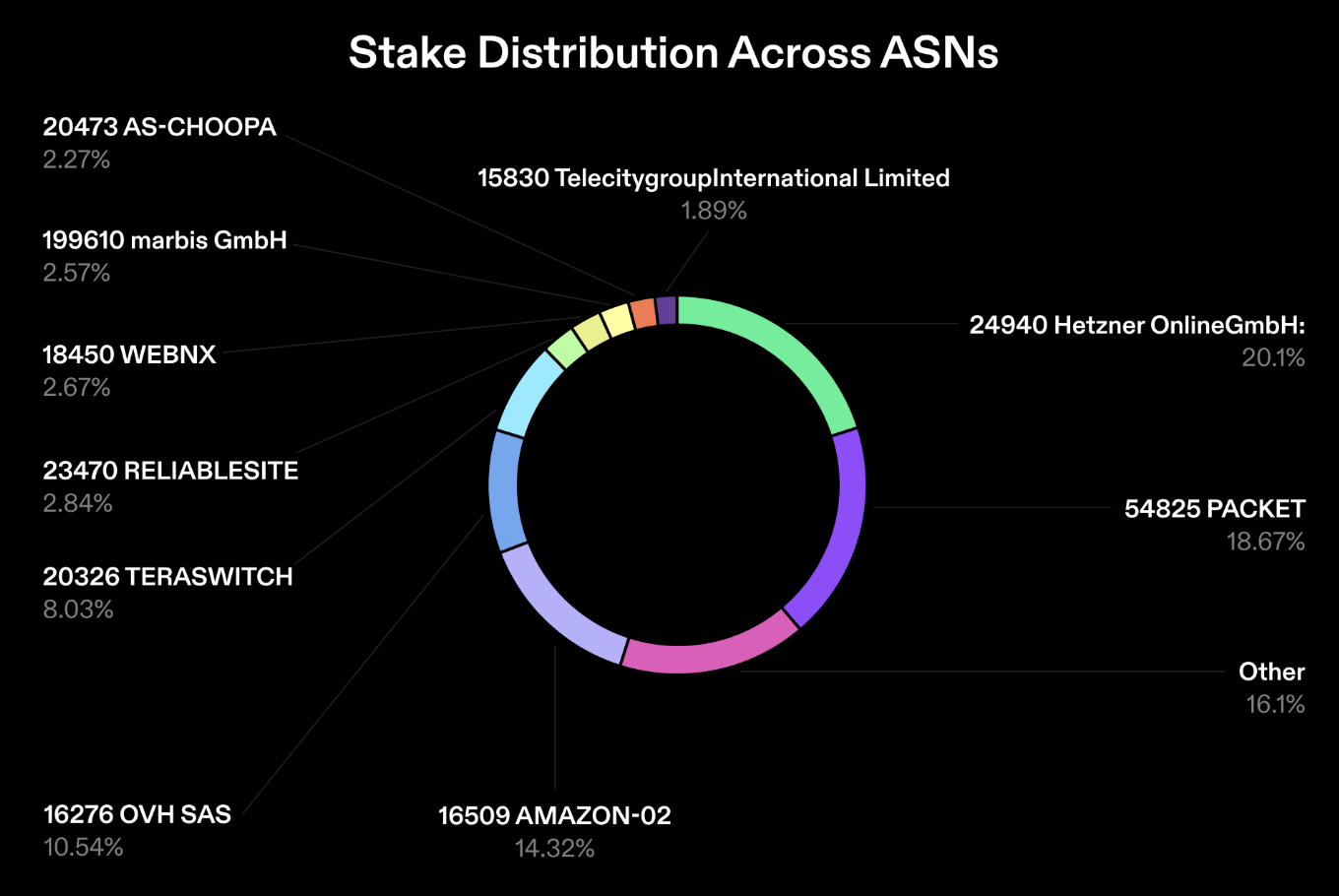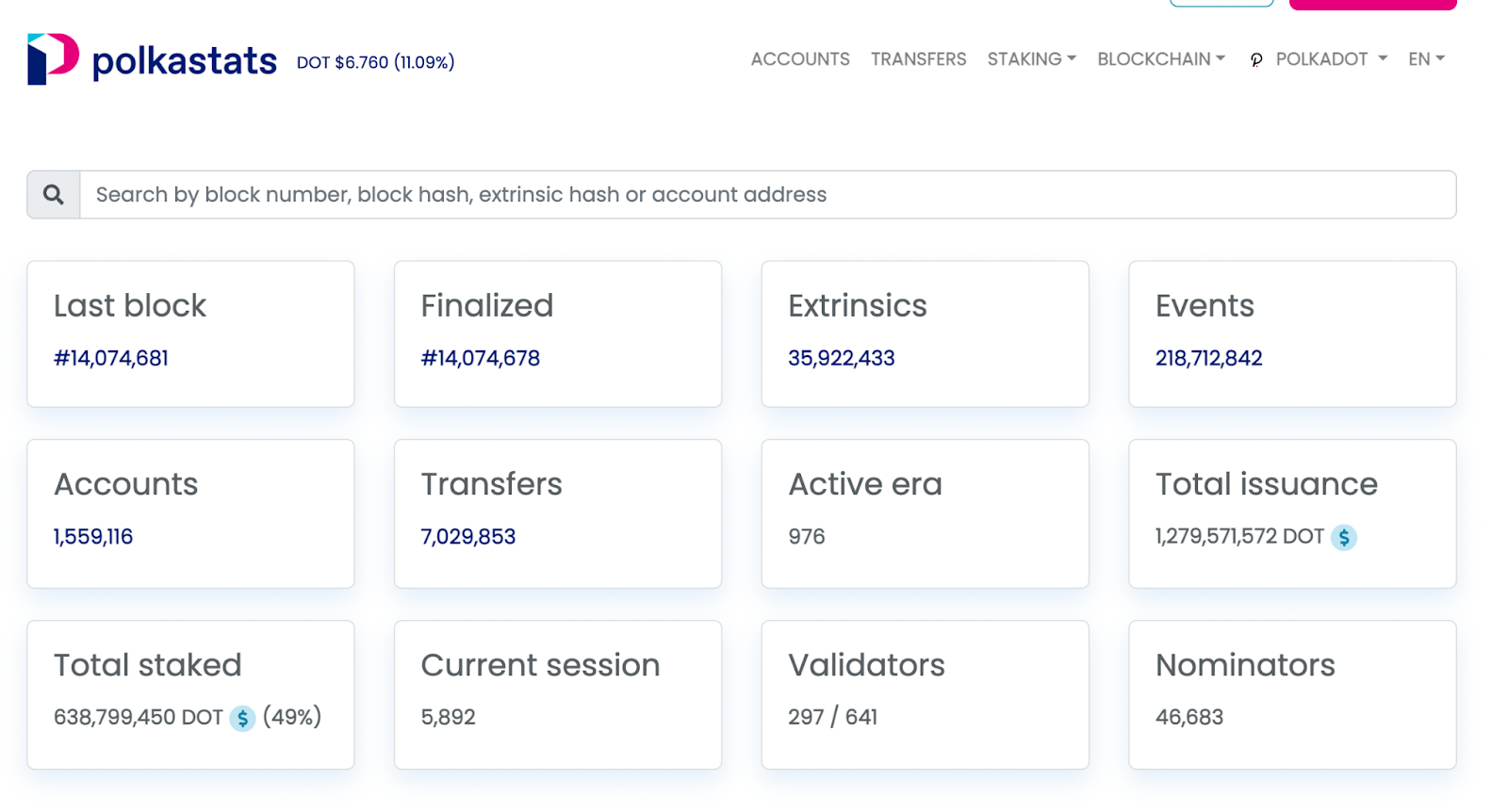Ever since Ethereum executed The Merge in September, there’s been a lot of debate around the ramifications of Proof of Stake.
Now with regulators and lawmakers poised to introduce a slate of potential rules on cryptocurrencies, analyzing the blockchain infrastructure of Proof of Stake-based consensus is more important than ever.
We can assess a number of risks and key data points to understand the state of decentralization. These include:
- Percentage of Staked Tokens
- Distribution of Token Holders
- Number of Validators
- Geographical Distribution of Nodes
- Diversification on Cloud Providers
- Decentralized vs Centralized Staking
Ethereum compared to Polkadot, Solana & Avalanche:
Percentage of staked tokens & Distribution of token holders
Let’s start by checking basic supply and token distribution data among the ecosystems.
Ethereum is the No. 2 blockchain by market capitalization ($200B) with a total circulating supply of 120 Million ETH.
About 88M ETH are held in accounts, 16M ETH are locked in smart contracts, and 16.3M ETH are staked in validator nodes participating in the consensus.
Polkadot, the No. 12 cryptocurrency, is next with 898.5M in circulation DOT out of a total supply of 1.27 Billion DOT. More than 638M DOT, or half of the total supply, is staked.
Solana is No. 11 with a total supply of 539M SOL. According to staking metrics, there are 377.8M SOL in stake, out of 372M SOL in circulation.
Avalanche, No. 15, has a circulating supply of 314.9 Million AVAX out of a total supply of 720M AVAX, and 60% of the coins are staked, with over 264M AVAX in active validation.




Number of Validators
On the infrastructure side, the Ethereum blockchain currently has more than 508,400 validator nodes as part of the new Proof of Stake consensus, securing over $20B USD worth of ETH.
Polkadot functions with only 297 active validators in the consensus, and another 641 in standby, participating in the consensus on a rotation basis.
Solana counts 1,847 active validators out of the 3,011 connected nodes, and Avalanche presents a similar number with 1,118 validators. The overwhelming difference between the hundreds of thousands nodes versus a couple thousand or even less, gives Ethereum a considerable lead on this matter.

Geographical Distribution of Nodes
The resilience of a network can be linked to the geographical distribution of its nodes, due to the ability to avoid jurisdictional concentration risks. This topic is especially important for fostering uncensorable ecosystems. Ethereum, Polkadot, Solana and Avalanche have a visible concentration of their infrastructure in Europe and North America, with more than half of the total nodes located in these regions. Germany, the United States and the United Kingdom are the top locations for the our protocols.



Diversification on Cloud Providers
According to ethernodes, on the Ethereum mainnet charts, more than half of the nodes surveyed are running on top of Amazon Web Services (AWS), the cloud computing division of the giant online retailer, with over 65% of Ethereum third-party hosted nodes. There is no public data available for this metric on Polkadot validators so far.

There is no on-chain data available for these metrics on Solana either. A report by the Solana foundation published in 2022 shows the level of distribution by Autonomous System number (ASN). It is a network of servers with a single routing number, and Amazon Web Services accounts for 14% of hosted infrastructure, while Hetzner Online, a German company, has 20%.
In the case of the Avalanche blockchain, AWS supports almost 21% of the infrastructure deployed, but more than half of the network is diversified on independent providers. This makes it less dependent on centralized infrastructure by cloud providers.


Decentralized vs Centralized Staking
Pool distribution can be seen as the concentration of ETH on different staking platforms, where Lido has over 25% of the pie, then Coinbase 11.5%, Kraken 7% and Binance 5.29%. If we sum the centralized staking services by exchanges amounts over 25% of total Ethereum staking.

Polkadot is slightly different with nomination pools. This can be seen as points of centralized staking behavior, where currently only 64 of them represent a great part of the stake delegations.
According to the Network Health Report 2022 by the Solana Foundation, 1,688, or 88% of its consensus-producing validators are run by independent entities. There is no public on-chain data for both Solana and Polkadot.
For AVAX staking we could find only the top 10 stake managers. Two infrastructure providers appeared to have a significant amount of 7M AVAX under control; this is almost 21% of the 34M AVAX under delegation.

The state of decentralization on Proof of Stake networks varies among different models and experiences. Ethereum, the largest and most well-known PoS network, has the lead in number of nodes and a relatively balanced distribution of token holders.
Polkadot, Avalanche, and Solana are newer blockchains that are growing at a good clip. All three networks have a high percentage of staked tokens due to the size of their supply, yet their distribution of token holders and infrastructure is less balanced. Additionally, the extent to which staking is decentralized or centralized on these networks is not yet clear.
Well-Balanced
Overall, the four blockchains fail to have a well-balanced distribution of their infrastructure around the globe, even more noticeable in the large use of cloud providers such as AWS that are concentrated in North America and Europe.
It is clear that decentralization is an important factor, and there is still work to do on the matter. Participants, users, and builders must focus on making adjustments to ensure the resilience of these ecosystems.
Alberto Guerrero Montilla is the head of growth at SenseiNode, and Pablo Larguia is the CEO of SenseiNode, a blockchain infrastructure provider in Latin America.
- SEO Powered Content & PR Distribution. Get Amplified Today.
- Platoblockchain. Web3 Metaverse Intelligence. Knowledge Amplified. Access Here.
- Source: https://thedefiant.io/state-of-proof-of-stake-report/
- 1
- 10
- 11
- 16M
- 2022
- 9
- a
- ability
- According
- Accounts
- active
- Additionally
- adjustments
- All
- Amazon
- Amazon Web Services
- Amazon Web Services (AWS)
- america
- among
- amount
- amounts
- and
- and infrastructure
- Another
- appeared
- around
- autonomous
- available
- Avalanche
- Avalanche Blockchain
- AVAX
- avoid
- AWS
- basic
- basis
- between
- Billion
- binance
- blockchain
- blockchains
- builders
- capitalization
- case
- centralized
- ceo
- Charts
- checking
- circulating
- Circulation
- clear
- Cloud
- cloud computing
- coinbase
- Coins
- company
- compared
- computing
- Concentrated
- concentration
- connected
- Consensus
- considerable
- contracts
- control
- could
- Couple
- cryptocurrencies
- cryptocurrency
- Currently
- data
- data points
- debate
- Decentralization
- decentralized
- dependent
- deployed
- difference
- different
- distribution
- diversified
- Division
- DOT
- Ecosystems
- either
- ensure
- entities
- especially
- ETH
- Ether (ETH)
- ethereum
- Ethereum blockchain
- ETHEREUM MAINNET
- ethereum staking
- Europe
- Even
- EVER
- Exchanges
- Experiences
- FAIL
- Find
- Focus
- Foundation
- functions
- future
- geographical
- German
- Germany
- giant
- gives
- globe
- good
- great
- Growing
- Growth
- Half
- head
- Health
- Held
- Hetzner
- High
- holders
- hosted
- HTTPS
- Hundreds
- important
- in
- include
- independent
- Infrastructure
- introduce
- IT
- Key
- Kingdom
- Kraken
- large
- largest
- Latin
- latin america
- lawmakers
- lead
- Level
- LIDO
- linked
- located
- locations
- locked
- Lot
- mainnet
- MAKES
- Making
- Managers
- Market
- Market Capitalization
- Matter
- metric
- Metrics
- million
- models
- more
- most
- network
- networks
- New
- next
- nodes
- North
- north america
- number
- On-Chain
- on-chain data
- online
- online retailer
- part
- participants
- participating
- percentage
- Platforms
- plato
- Plato Data Intelligence
- PlatoData
- points
- Polkadot
- Pools
- PoS
- PoS Network
- potential
- presents
- promise
- proof
- Proof-of-Stake
- protocols
- provider
- providers
- public
- published
- regions
- Regulators
- relatively
- report
- represent
- resilience
- retailer
- Risk
- risks
- Run
- running
- securing
- September
- Services
- Shows
- significant
- similar
- since
- single
- Size
- slightly different
- smart
- Smart Contracts
- So
- so Far
- SOL
- Solana
- Solana Foundation
- stake
- Staked
- Staking
- staking services
- start
- State
- States
- Still
- such
- supply
- Supports
- surveyed
- system
- The
- The Coins
- The State
- the United Kingdom
- their
- third-party
- thousands
- three
- to
- token
- token holders
- Tokens
- top
- Top 10
- topic
- Total
- under
- understand
- United
- United Kingdom
- United States
- USD
- use
- users
- validation
- Validator
- validator nodes
- validators
- Versus
- visible
- web
- web services
- well-known
- which
- while
- Work
- worth
- zephyrnet










